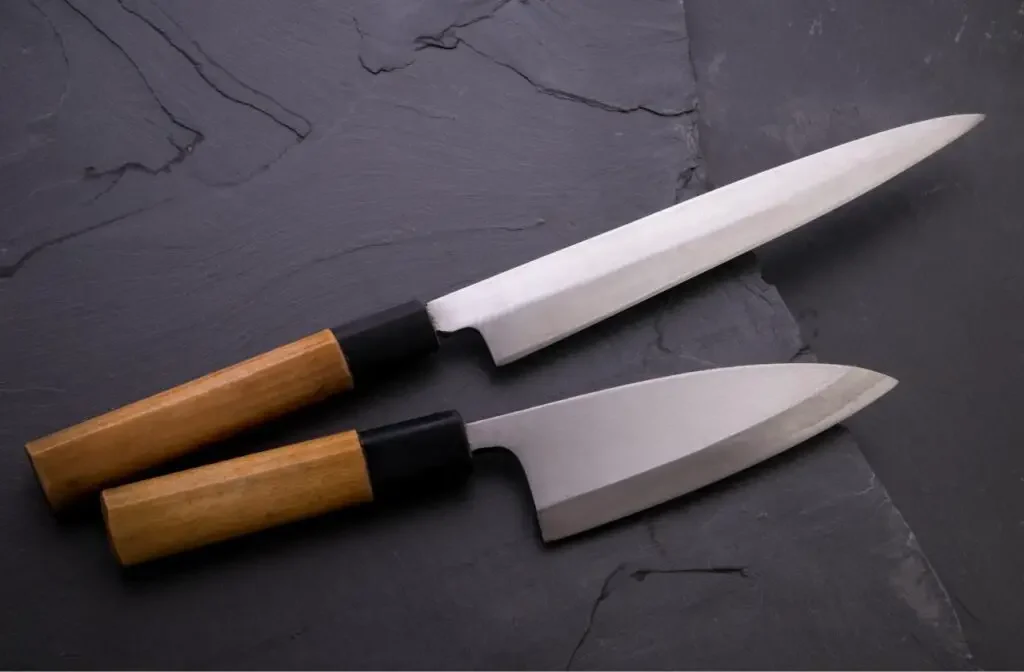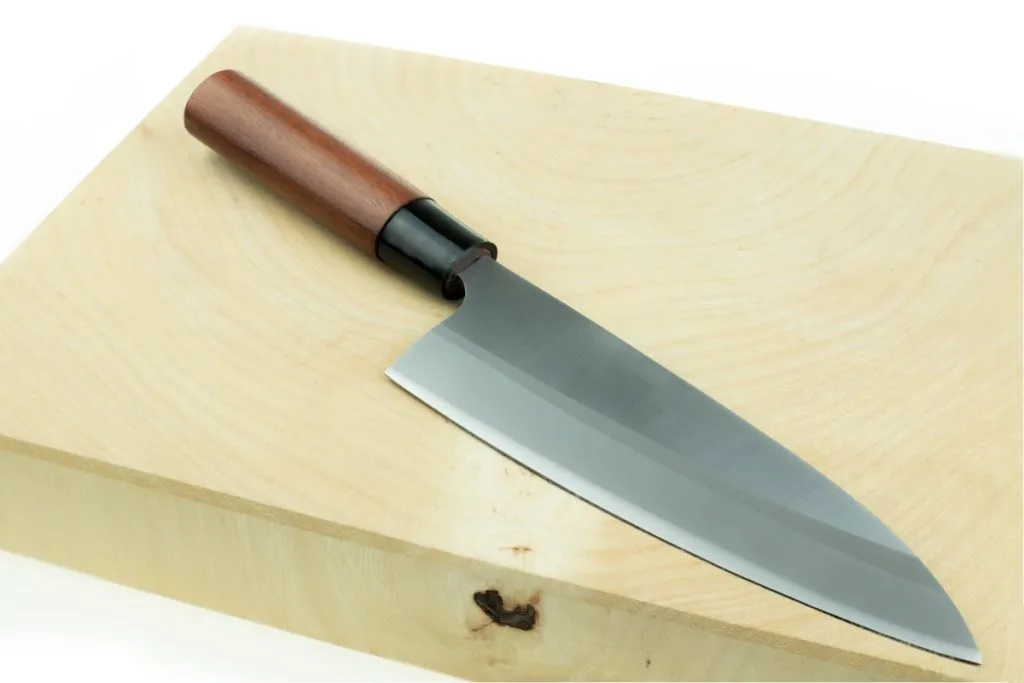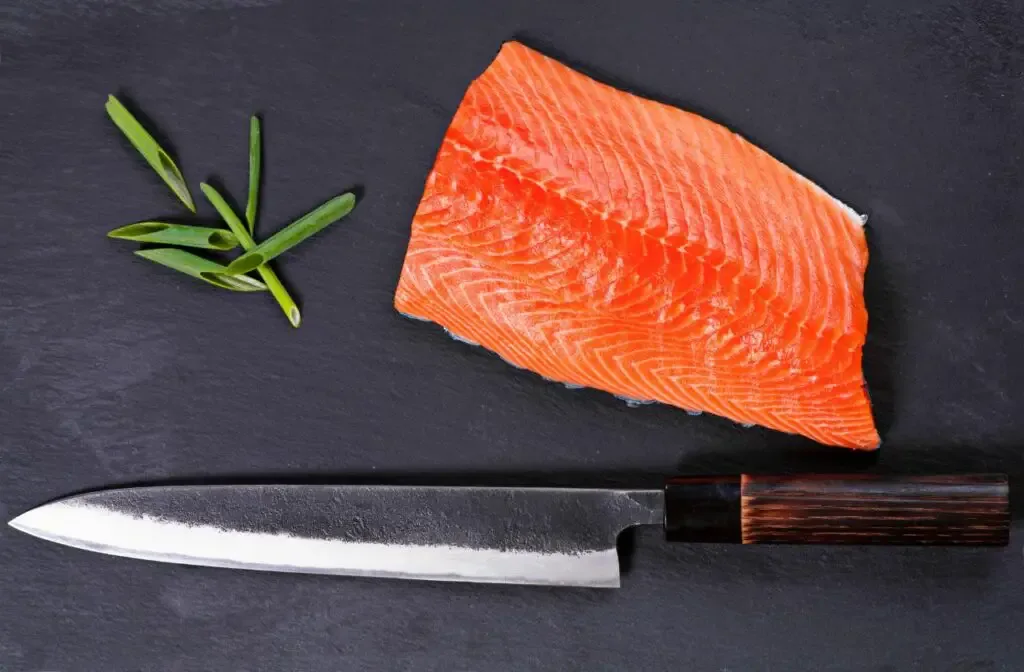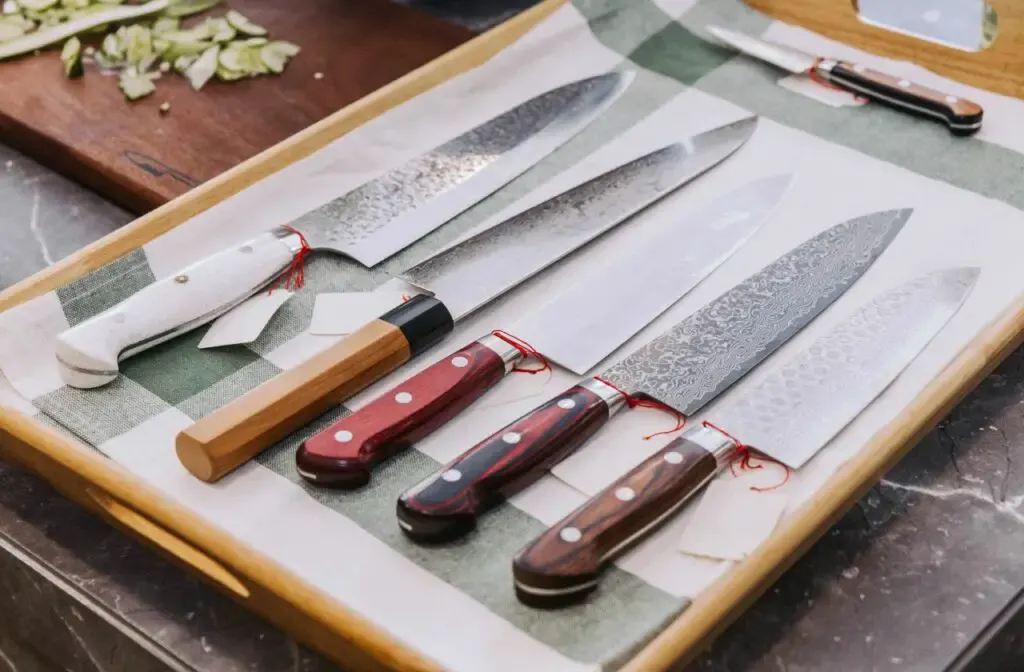As an Amazon Associate, we earn from qualifying purchases with no additional costs for you.
Single-bevel Japanese knives have benefits as well as some challenges, particularly in terms of the knife’s maintenance. Which Japanese kitchen knives are traditionally single-bevel knives, and how would you use and take care of these knives?
Traditionally, most Japanese knives were single bevels. Double bevel knives were produced for the Western market, but the Yanagiba, Usuba, and Deba are still preferred with single bevels because of the specific purpose of these knives. Single-bevel knives require more skill to use and sharpen.
Single-bevel knives are the pinnacle of sharpness and precision in Japanese kitchen knives. However, knives with these blade grinds may not be for everyone. A single-bevel knife also comes with a higher demand for advanced knife techniques as well as maintenance complications.
If you are interested in checking out the best Japanese knives (made by Hayate Yoshihiro) we recommend and use, you can find them by clicking here (Amazon link).

Single Bevel Japanese Knife Types
All Japanese knives are traditionally made with single bevels since this was the standard for sharpening their knives.
When the demand for double-bevel knives from the Western world began to increase, many Japanese knife manufacturers began producing double-bevel Japanese knives to cater to the preference in the Western market.
However, some Japanese knives made for particular purposes are still single bevel since these knives’ cutting tasks are intended to benefit from this type of edge.
The main Japanese knives that retain the traditional single bevel are as follows.
The Single Bevel Yanagiba
The Yanagiba, sometimes called a Shobu, is a long-bladed knife designed specifically to prepare a Japanese dish called sashimi. Yanagiba means “willow blade,” which refers to the thin, wispy blade of the knife.
Sashimi is thinly sliced raw fish, which requires the precision and sharpness of a single bevel blade to produce a clean, thin slice with one stroke of the blade.
The blade’s length allows the chef to pull the entire length of the blade through the ingredients to cut through in a single stroke. This prevents the need to cut, lift the knife, position the blade in the cut, and finish the slice.
The clean cut with a single stroke of the knife produces an extremely thin, even clean cut through the fish, enhancing the dish’s visual appeal.
The Single Bevel Usuba
The name Usuba bocho literally means “thin knife” and is traditionally a vegetable processing knife, usually reserved for use by professional chefs.
The Usuba is preferred by professional chefs because the single bevel produces a more accurate, cleaner slice through the vegetables. The Usuba is similar to the Nakiri in shape and purpose, with the main difference being the Usuba is a single-bevel knife, and the Nakiri is a double-bevel knife.
The Nakiri is considered a vegetable processing knife for use in a home kitchen, while the Usuba is intended for professional chefs. This is because the single bevel requires more skill to use and take care of.
The Usuba allows the cutting of thinner slices of vegetables, even hard vegetables, without applying pressure, which can bruise or crack the ingredient. The Usuba is also used to make katsuramuki cuts, shaving cylindrical vegetables into long, thin sheets.
This type of precise vegetable processing is generally not required in a home kitchen, where the Nakiri is preferred for vegetable processing.
TIP: A Japanese kitchen knife is a precision tool that should not be treated as a multi-purpose utility knife. Find out what to cut and not to cut in the article below:
Complete List: What NOT TO CUT With Japanese Knives & Why?
The Single Bevel Deba
The Deba is intended to process fish, poultry, and slicing meat. The primary purpose of the Deba, which means “pointed carving knife,” was to fillet fish and cut the head off the fish. This requires a more robust knife to handle cutting through the fish and the bones at the head.
The knife’s heel is usually thicker to provide added strength to the blade for cutting through small bones.
The design of the forward part of the blade is intended to ease the task of running the knife along the fish’s ribs and spine to cut the fillet from the fish.
The Deba comes in various sizes, ranging from a 4.7-inch (120mm) blade to a larger 8.3-inch (210mm) blade.
BTW: If you want to know more about Japanese and other knives and their sharpening, check out the books listed above. These books are recommended by professional sharpeners and knife makers (Amazon links):
- Japanese Kitchen Knives: Essential Techniques and Recipes
- The Knifenerd Guide to Japanese Knives
- Knife: The Culture, Craft, and Cult of the Cook’s Knife
- Sharp: The Definitive Introduction to Knives, Sharpening, and Cutting Techniques, with Recipes from Great Chefs
Best Japanese Single Bevel Knife

The best single-bevel Japanese knife is the Deba. This is mainly due to the greater versatility of the Deba for a wide range of meat processing tasks in the kitchen.
Although the Deba’s primary intention is for fish processing, it can be used to process poultry in the kitchen as well as slice other meat. It is best to slice boneless cuts of meat when slicing other meat since large bones can damage the Deba’s edge.
A Deba is a good first-time Japanese knife to try, especially if it will be your first single-bevel knife. Sourcing a quality single-bevel Japanese knife can be challenging if you don’t know where to look or what to look for.
We can recommend the Yoshihiro Shiroko High Carbon Steel Deba (Amazon link) as a great single-bevel knife to add to your kitchen knife collection!
TIP: Choosing your first Japanese knife can raise a few questions about which style of knife to choose. Check out the ultimate guide about buying your first Japanese knife in the article below:
Choosing Your First Japanese Knife (Ultimate Guide + Tips)
Pros And Cons Of Japanese Single Bevel Knives

As we have already mentioned, a single-bevel knife brings many benefits to its use in the kitchen, but it also presents some challenges to the knife owner.
Any knife has pros and cons, and we will briefly discuss the pros and cons of single-bevel knives in general to give you an idea of what to expect from knives with this type of edge.
Pros Of Single Bevel Knives
There are several benefits of single-bevel knives that double-bevel knives cannot match due to the geometry of the edge.
- Sharpness. The single bevel allows for a much finer cutting edge, allowing single-bevel knives to be much sharper than double-bevel knives.
- Higher precision in the cuts. The keenness of the edge allows for more precision to cut thin, even, clean slices. This precision in the cut improves the aesthetics of the sliced ingredients, making single-bevel knives popular where visual appeal is required for the dish’s presentation.
- Reduces cutting pressure required. Single-bevel Japanese knives are not completely flat on the non-angled side of the blade. The flat side of the blade has a slight concave grind, which breaks the surface tension between the ingredient and the knife, allowing the knife to pass effortlessly through the food.
Cons Of Single Bevel Knives
Single-bevel knives are great for their intended purpose, but they have some disadvantages that can make use and maintenance challenging.
- Durability. The fine edge on a single-bevel knife allows for a greater degree of sharpness, but the thin edge is not as durable as a double-bevel knife and can be damaged if used improperly.
- Sharpening. Many people say single-bevel knives are easier to sharpen, but this is not the case. The fineness of the edge requires a greater level of skill to correctly sharpen the edge, and incorrect sharpening techniques can damage the edge more easily.
- Require more skill to use. A single bevel requires a greater level of knife skills to use correctly and prevent damage to the knife.
TIP: Grooves, dents, and other textures are sometimes featured on Japanese knives. Find out why Japanese knives have them in the article below:
3 Reasons Why Japanese Knives Have Grooves Or Dents
How To Use Japanese Single Bevel Knife

The blade design of single-bevel knives includes a more robust heel and a more refined tip on the knife. This design is for the way the knife is intended to be used.
Heavier duty tasks such as removing a fish head with a Deba require the use of the blade’s heel. The heel is the section of the blade closest to the knife’s handle.
The more agile forward section of the blade is intended for more delicate work, such as removing the fillet from a fish, in the case of a Deba.
An important aspect of single-bevel kive use is to never twist the knife in a cut or use a lateral movement of the blade during the cut. The fine edge of the knife is not intended to be used in this way, and it can crack or chip, requiring significant repairs to the edge.
Maintaining Single Bevel Japanese Knives

Maintaining single-bevel Japanese knives is challenging, especially when the objective is to preserve the exquisite sharpness and integrity that these culinary tools are celebrated for. These knives can be more delicate than other knife types, and maintaining the useability and functionality of these knives is not always easy.
Chefs and home cooks alike often find themselves grappling with ensuring these knives not only retain their precision but also endure through time and use.
The acute sharpness of single-bevel knives, while being their most significant asset, also presents a challenge as the edge is prone to chipping and demands careful handling during use and sharpening.
Achieving the optimal angle during sharpening, pivotal for maintaining the blade’s efficacy, demands a certain level of expertise and practice. Furthermore, high-carbon steel, often employed in crafting these knives, is susceptible to rust and corrosion if not dried and stored properly.
Mastering the sharpening technique involves employing a quality whetstone and familiarizing oneself with the correct grit number suitable for the knife, maintaining a consistent angle, typically around 15 degrees for Japanese knives, throughout the sharpening process, and engaging in regular honing to realign the blade’s edge, preventing it from becoming dull.
Combatting rust and ensuring longevity involves washing the knife immediately after use, avoiding any acidic or corrosive substances lingering on the blade, ensuring the knife is thoroughly dried before storing it to prevent rusting, and utilizing a magnetic knife strip or a wooden block for storage, ensuring the blade does not come into contact with other utensils.
Mindful usage includes ensuring that the cutting surface is soft and forgiving, like a wooden or rubber cutting board, to prevent chipping and adopting a straight up and down cutting motion, avoiding any lateral movement that could damage the edge.
Ensuring a keen edge as a maintenance tip involves considering occasional professional sharpening to rectify any minor damages and ensure the blade is in optimal condition, lightly oiling the blade, especially for knives that are not used frequently, to prevent oxidation and rust, and always handling the knife with care and ensuring it is stored safely, protecting both the blade and the user.
Incorporating these meticulous maintenance practices will not only enhance the longevity of your Japanese single bevel knives but also ensure they continue to provide the unparalleled precision and performance they are celebrated for.
Remember, the essence of these knives lies in their meticulous craftsmanship – mirroring this in their care ensures a symbiotic relationship between the culinary artist and their tools.
Conclusion
Single-bevel knives offer a greater level of sharpness and precision to the cut they can produce. While these knives are traditionally seen as more in the domain of a professional chef, there is no reason why you cannot enjoy the benefits of a single-bevel Japanese knife in your home kitchen!
If you are not a skilled knife sharpener, it would be beneficial to have your single-bevel knife professionally sharpened to take proper care of the edge.
TIP: Sharpening a knife is a learned skill, with right and wrong ways of performing the task. This is really important when you are sharpening your Japanese knives. Check out more in the article below:
Push Or Pull When Sharpening A Knife? Correct Way Explained
